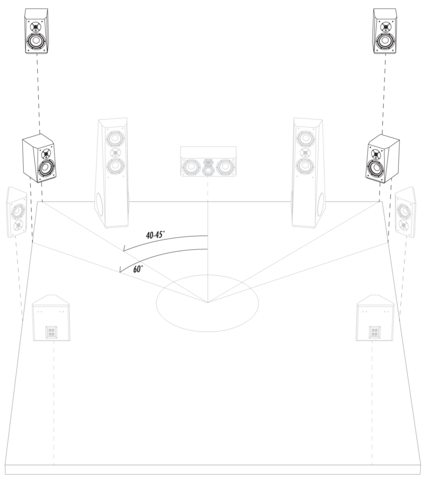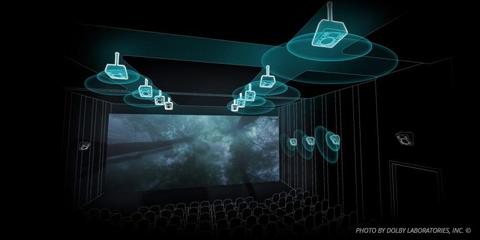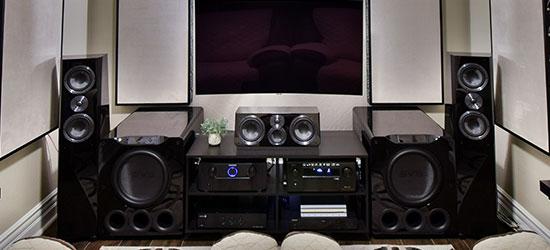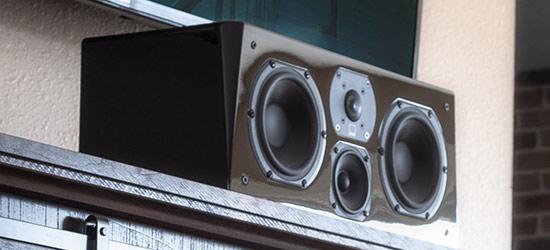The Art of Speaker Placement
How to Place Your Speakers for the Best Sound
SVS receives lots of questions about loudspeaker and subwoofer placement for home theater and stereo systems. We’ve already covered subwoofer placement, so this article will focus on the loudspeaker channels.
When home theater was in its relative infancy, a 5.1 speaker system was state-of-the art. Now even 7.1 is standard and 9-channel and 11-channel surround sound processors are increasingly common. Emerging audio formats like Dolby Atmos, DTS:X and Auro-3D are also bringing immersive height effects into the home, creating more channels that extend to 5.1.2, 7.1.4, 11.2.6 and beyond.
Regardless of the number of speakers in a home audio system, the final goal is the same – precise localization of special effects, a spacious sound stage, seamless panning across all channels and three-dimensional imaging. This can only occur if each speaker channel is properly placed.
Speaker Placement For 2-channel Stereo Systems
When setting up speakers for a 2-channel speaker system, the two speakers and the listener’s head should form the three points an equilateral triangle. The listening position is determined by the "center to center" distance of the speakers from each other and the distance to the listener’s head. It does not refer to the room dimensions in any way. The importance of symmetrical speaker placement for near field listening, especially in small to medium sized rooms, is hugely important for optimizing stereo sound quality.
After the speakers and main listening position are set as close to a perfect equilateral triangle as possible, the speakers must be angled slightly toward the listening position (also called toeing in). This can be done by ear and usually a ¼ to ½ inch toe-in is sufficient. When done correctly, you will be able to clearly perceive a center focused voice when the sweet spot is hit.
Speaker Placement For 5.1 And 7.1 Surround Sound Systems
 Front Left/Right Mains Speakers
Front Left/Right Mains Speakers
The main speakers should be placed 25-30 degrees off-axis, relative to the primary seating position. The best imaging will be obtained when the tweeters are close to ear height when seated. Most tower speakers accomplish this naturally, and a bookshelf monitor will require stands.
Pulling the main speakers away from the corners (to the extent allowed by room traffic) will reduce boundary reflections and improve imaging.
Center Channel SpeakerThe center channel should be placed directly on-axis, relative to the primary seating position. As with the main front speakers, placing the tweeter at/near head level when seated is optimal. But depending on the placement of the video display or projection screen, this is not always possible.
If the center channel must be located below head level, then an upward tilt of the speaker is recommended to improve mid/high frequency response and dialogue intelligibility. For more in-depth advice, check out our article on Center Channel Speaker Placement Tips.
Side Surround SpeakersIn a 5-channel system, the side surround speakers should be located 90-110 degrees off-axis. For the best sense of spaciousness, the tweeter height should be about 2 feet above ear level.
Rear Surround SpeakersIn a 7.1 system, dedicated rear surround speakers are placed behind the primary seating position for enhanced rear panning effects.
Place the rear surround speakers at 135-150 degrees off-axis, relative to the primary seating position. As with the side surround speakers, position the rear surround tweeters about 2 feet above head level when seated.
Speaker Placement For 9.1 And 11.1 Systems

The development of 9- and 11-channel surround sound processors brings Wide and Height ‘presence’ channels into the system to even further enhance sound stage spaciousness and immersion. Since native Blu-ray formats are currently only available in 7.1, the use of Wide or Height speakers requires the use of an upconverting algorithm in the surround sound processor - like Audyssey DSX, DTS Neo:X and Dolby ProLogic IIz.
Wide Speaker ChannelsThe wide speaker channels are intended to be placed between the main front speakers and the side surround speakers. The goal of the wide speaker is to minimize any gaps in panning and imaging between the front main speakers and the side surround speakers and provide an additional sense of envelopment.
The optimal location for the wide speakers is about 60 degrees off-axis, relative to the primary seating position. Audyssey recommends that the wide speakers be placed at head level when seated.
Height Speaker ChannelsThe height speaker channels should be placed in the upper left/right corners of the front stage. Typically, this will be 40-45 degrees off-axis and about 8 feet in height. A downward tilt of the speaker will improve mid/high frequency response and reduce ceiling bounce reflections.
The height speakers enhance imaging in the vertical plane and can even be used to create sound effects which seem to come from directly above the listening position, which provides total immersion into the surround sound experience.
Beyond 11 Channel – Dolby Atmos

Introduced several years ago to commercial movies theaters, Dolby Atmos adds ceiling-mounted speakers to create special effects which emanate from above the viewer. More recently, DTS:X and Auro-3D have expanded the options for object based surround sound and height effects speakers. This brings a new and thrilling dimension of realism to the cinema experience.
Implementing Dolby Atmos in a home theater involves either mounting speakers like the SVS Prime Elevation high on a side wall and firing down, in the ceiling, or by adding Dolby-Atmos-enabled speaker modules which fire upward at the ceiling, thus relying on boundary reflection to provide the illusion that the special effects are originating from overhead.
For a more deeper look at the new object based surround sound formats, check out this article, Getting Started with Dolby Atmos, DST:X and Auro-3D.
Ready for an upgrade?
If the time has come to upgrade your speaker system, SVS has the acclaimed Prime Series and reference Ultra Series speakers. All SVS loudspeakers are timbre-matched so you can mix Prime and Ultra Series in a home theater system and never have to worry about voicing or phase issues. They blend seamlessly together.
Browse SVS Speakers by Series

Prime Series Speakers
Truly immersive and high-end in every way, SVS Prime Series speakers borrow technology breakthroughs from the Ultra Series to set all performance benchmarks in their class making world-class audio more inclusive than ever before.
View Prime Series
Ultra Series Speakers
Every design aspect was scrutinized to achieve cost-no-object sound quality. Delivering a detailed soundstage with breathtaking transparency, and deep, articulate bass; the Ultra Series stand toe-to-toe with the finest loudspeakers in the world.
View Ultra Series
Prime Wireless Speakers
A perfect fusion of intelligent control, endless versatility, future-facing connectivity options and most importantly, immersive, reference quality sound; SVS is changing the game with SVS Prime Wireless.
View Prime WirelessAudio System Setup Articles

5 Ways to Improve the Sound of Your TV

Which Sounds Better, Vinyl or Digital Music?

Why a Center Channel is the Most Important Speaker in Your Home Theater
Share Your Thoughts




